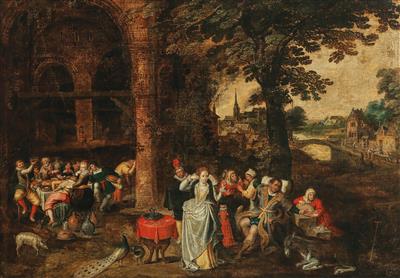Attributed to David Vinckboons

(Mechelen 1576 - before 1633 Amsterdam)
An Allegory of the Seven Deadly Sins,
oil on canvas, 112 x 161 cm, framed
Provenance:
Private European collection, since circa 1980;
acquired in 2019 by the present owner
The present picture is a vivid and humorous depiction of the seven deadly sins. Although likely executed in the Northern Netherlands, David Vinckboons was both a Fleming and a contemporary of Pieter Brueghel the Younger, whose father had popularised many of the motifs in the present composition in his widely known engravings depicting the individual sins. The outdoor setting before a portico and idealised townscape, with the fine dress of those feasting, identifies the work as part of the eroticised genre of the ‘Merry Company.’ In the foreground, the lady with a looking glass is a decorous representation of Superbia, attended by a peacock lower left. On the right, a pair of finger-wagging figures may represent Invidia. A gluttonous peasant leans back beside a slothful donkey resting on its haunches. On the left of the composition, Luxuria is represented by a lady gently fingering the tip of a gentleman’s poignard, while Brueghelian elements are most pronounced in the man micturating in the background beneath the arch and another vomiting against a pillar.
David Vinckboons was born into a family of artists in Malines in 1576. His grandfather Gillis had settled there in 1489 and had opened a studio of painting in watercolour on canvas – a Malines specialty continued by his son Philip (1545–1601). Due to the political and religious situation of the day, Philip moved his business to Antwerp in 1579, where he is recorded from 1580 until 1586. As the situation deteriorated for the reformed community to which the Vinckboons belonged, in late 1586 Philip travelled to the North with 185 other Antwerp families under safe conduct granted by the Earl of Leicester, Governor General of the United Provinces. Here he first settled in Middelburg and from 1591 in Amsterdam. With other religious immigrants from the South, such as Gillis van Coninxloo and Hans Bol, the Vinckboons family formed a tight artistic community in Amsterdam and continued their businesses as before. Thus, David received his training from his father and first specialised in paintings in watercolour on canvas, such as his forebears had done. Later he took up painting in oil, mostly on smaller formats, which Karel van Mander praises as having considerable merit. His compositions must have been popular since they were frequently engraved.
Esperto: Damian Brenninkmeyer
 Damian Brenninkmeyer
Damian Brenninkmeyer
+43 1 515 60 403
oldmasters@dorotheum.com
09.06.2020 - 16:00
- Stima:
-
EUR 40.000,- a EUR 60.000,-
Attributed to David Vinckboons
(Mechelen 1576 - before 1633 Amsterdam)
An Allegory of the Seven Deadly Sins,
oil on canvas, 112 x 161 cm, framed
Provenance:
Private European collection, since circa 1980;
acquired in 2019 by the present owner
The present picture is a vivid and humorous depiction of the seven deadly sins. Although likely executed in the Northern Netherlands, David Vinckboons was both a Fleming and a contemporary of Pieter Brueghel the Younger, whose father had popularised many of the motifs in the present composition in his widely known engravings depicting the individual sins. The outdoor setting before a portico and idealised townscape, with the fine dress of those feasting, identifies the work as part of the eroticised genre of the ‘Merry Company.’ In the foreground, the lady with a looking glass is a decorous representation of Superbia, attended by a peacock lower left. On the right, a pair of finger-wagging figures may represent Invidia. A gluttonous peasant leans back beside a slothful donkey resting on its haunches. On the left of the composition, Luxuria is represented by a lady gently fingering the tip of a gentleman’s poignard, while Brueghelian elements are most pronounced in the man micturating in the background beneath the arch and another vomiting against a pillar.
David Vinckboons was born into a family of artists in Malines in 1576. His grandfather Gillis had settled there in 1489 and had opened a studio of painting in watercolour on canvas – a Malines specialty continued by his son Philip (1545–1601). Due to the political and religious situation of the day, Philip moved his business to Antwerp in 1579, where he is recorded from 1580 until 1586. As the situation deteriorated for the reformed community to which the Vinckboons belonged, in late 1586 Philip travelled to the North with 185 other Antwerp families under safe conduct granted by the Earl of Leicester, Governor General of the United Provinces. Here he first settled in Middelburg and from 1591 in Amsterdam. With other religious immigrants from the South, such as Gillis van Coninxloo and Hans Bol, the Vinckboons family formed a tight artistic community in Amsterdam and continued their businesses as before. Thus, David received his training from his father and first specialised in paintings in watercolour on canvas, such as his forebears had done. Later he took up painting in oil, mostly on smaller formats, which Karel van Mander praises as having considerable merit. His compositions must have been popular since they were frequently engraved.
Esperto: Damian Brenninkmeyer
 Damian Brenninkmeyer
Damian Brenninkmeyer
+43 1 515 60 403
oldmasters@dorotheum.com
|
Hotline dell'acquirente
lun-ven: 10.00 - 17.00
old.masters@dorotheum.at +43 1 515 60 403 |
| Asta: | Dipinti antichi |
| Tipo d'asta: | Asta in sala |
| Data: | 09.06.2020 - 16:00 |
| Luogo dell'asta: | Wien | Palais Dorotheum |
| Esposizione: | 02.06. - 09.06.2020 |
